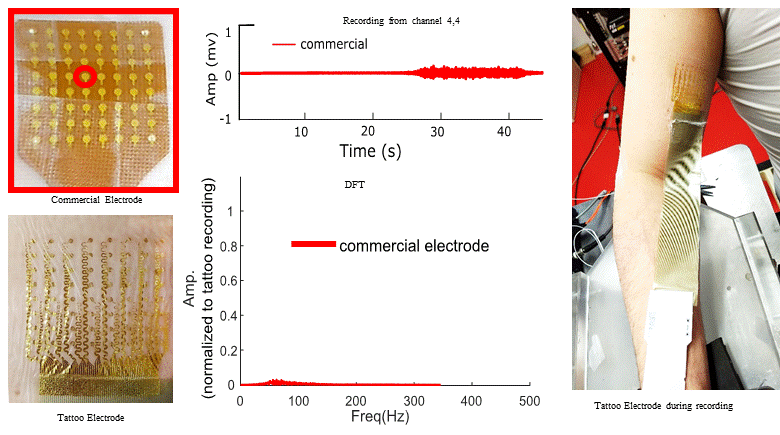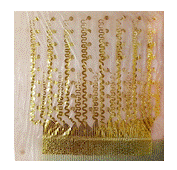
High-density surface electromyography (HD-sEMG) recording has been utilized for several distinct purposes in the last few decades. Detection of muscle innervation zone, estimation of motor unit action potential conduction velocity, decompositions of individual motor units are some of the important applications. However, widespread clinical acceptance of HD-sEMG is currently limited by the characteristic inadequacies of available electrode arrays. Commercial HD-sEMG electrodes have a fixed layout with limited spatial fidelity which is further constrained by the need to apply electrode gel/paste. Ensuring uniform skin-electrode contact is another limitation for using the electrode because of the mechanical properties of the electrode array.
Here we demonstrate and evaluate a 64-channel 3cmx2cm tattoo electrode array for HDsEMG recording, with a 2mm diameter of each Au-based electrode. The tattoo was built on a stretchable electronics structure that can be extended by up to 37% of its initial length. The tattoo electrode offers remarkable skin conformity and does not require the application of electrode gel/paste. It also offers seamless programmability of the array layout, electrode size, and shapes.
The tattoo electrode was placed on the biceps brachii of intact human subjects and the signal was recorded across all the channels during isometric voluntary contraction. The tattoo electrode was able to record signals in all the channels without any distortion during various levels of contractions and rest. The signal exhibited good baseline stability, faithful signal-to-noise-ratio, and consistent occupied bandwidth. Compared to the commercial electrode the tattoo recordings had significantly larger amplitude and higher power across the entire spectrum. Our analysis also affirms that the tattoo electrode was able to record larger peaks of the HDsEMG compared to the commercial electrode.
Together with easy wearability and faithful sEMG recording, the system will potentially offer a considerable advantage and open new avenues in clinical research (ALS, SMA, etc.).

